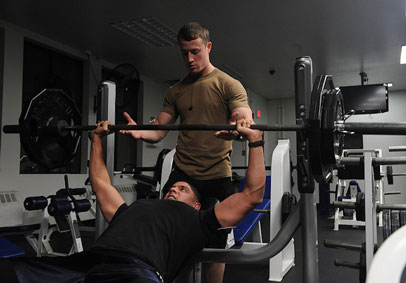The one-repetition maximum test, also called a one-rep max or 1RM, is used to find out the heaviest weight you can lift just once (but not twice). When you’re designing your resistance training program, you use different percentages of your 1RM, depending on whether you’re lifting to improve muscular strength, endurance, hypertrophy, or power. You can also do multiple-repetition tests and use them to figure out your 1RM. This is a good option if you’re lifting by yourself and don’t have someone to spot you.
Determining your 1RM
National Strength and Conditioning Association (NSCA) recommends the following protocol for determining your 1RM.
- Warm up with a light resistance that you can easily do 5–10 reps.
- Rest 1 minute.
- Continue the warm-up with a load that you can do 3–5 reps.
- For upper body lifts, add 10–20 pounds or 5–10% to the weight you used in step 1.
- For lower body lifts, add 30–40 pounds or 10–20% to the weight you used in step 1.
- Rest 2 minutes.
- Estimate a near maximal load that you can do 2–3 reps.
- For upper body lifts, add 10–20 pounds or 5–10% to the weight you used in step 3.
- For lower body lifts, add 30–40 pounds or 10–20% to the weight you used in step 3.
- Rest 2–4 minutes.
- Increase the weight.
- For upper body lifts, add 10–20 pounds or 5–10% to the weight you used in step 5.
- For lower body lifts, add 30–40 pounds or 10–20% to the weight you used in step 5.
- Attempt a 1RM.
- If you’re successful, repeat step 7. If you aren’t successful, rest 2–4 minutes, decrease the weight, and repeat step 8.
- For upper body lifts, remove 5–10 pounds or 2.5–5% of the weight you used in step 7.
- For lower body lifts, remove 15–20 pounds or 5–10% of the weight you used in step 7.
- Continue increasing or decreasing the load until you can complete one rep with proper technique.
You can use this protocol for a multiple-repetition test too. For example, for a 10-rep max test, determine the most weight you can lift 10 times, but not 11 times. 10RM tests are good for most exercises that hit large muscle groups and multiple joints (such as the bench press and dead lift) or assistance exercises that target small muscle groups and one joint (such as bicep curls).
Multiple-repetition tests for power exercises that are performed, such as the back squat or power clean, aren’t very reliable above 5RM because form breaks down quickly as you progress through the high-repetition testing sets and fatigue sets in. Remember, a max test is for the most weight you can lift with proper technique.
You can use NSCA’s training load chart to figure out what your 1RM would be based off of your multiple-rep test results. To use this chart, read across the first row for the number of reps you tested. The second row is the percent of your 1RM. So if you performed a 5RM test, that weight you lifted is about 87% of your 1RM.
You can use the chart to easily figure out different percentages of your 1RM too. For example, your bench press 1RM is 230 pounds, and you want to improve muscular strength (at least 85% of your 1RM). Read down the first column to 230 pounds, and then across to the 85% column (6 reps). The weight in that cell is 196 pounds, which is your 6RM, or 85% of your 1RM, and the amount you should lift for 4–6 reps.
NSCA recommends the following training loads for resistance training:
Muscular strength: 4–6 reps of at least 85% 1RM
Muscular hypertrophy: 6–12 reps of 67–85% 1RM
Muscular endurance: At least 12 reps of less than 67% 1RM
Now that you’ve figured out your training load, you can set your long-term workout goals and put together a periodized plan to really optimize your time in the gym.
Happy lifting!
